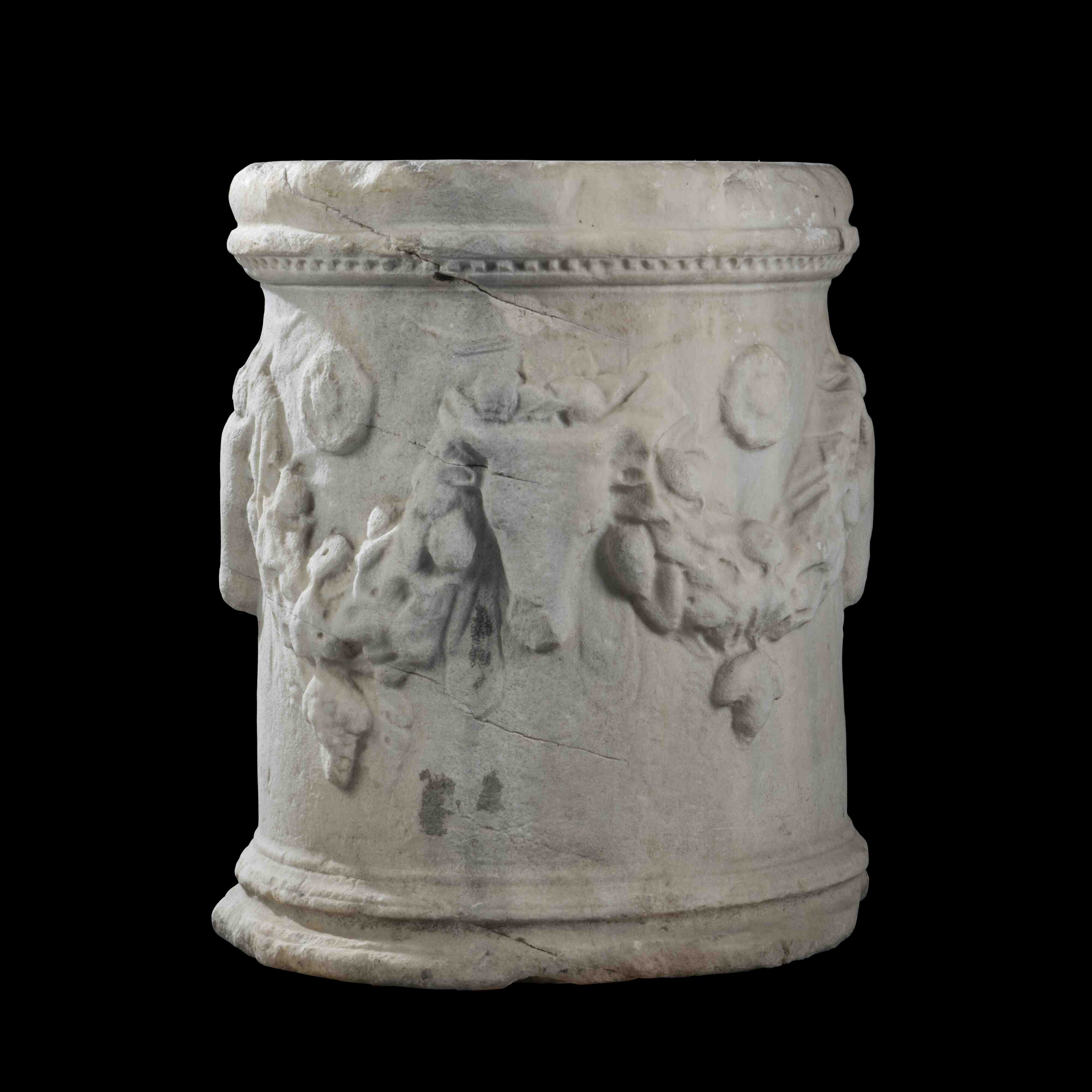With impressively defined, tensed musculature, this athlete stands in an uneasy upright position with weight planted  on his right leg, corresponding arm cocked to the rear, and torso leaning slightly backwards. The left leg is pulled back slightly on the diagonal with only the tips of the toes touch the ground, with the slight bend to both legs and their triangulated positioning providing more stability during the fight. The young pugilist is poised to strike a direct blow to his rival with his raised fist (wrapped in leather thongs that serves as ancient boxing gloves) while using his now missing extended right arm to fend off attacks and protect his face. His head is slightly turned to the right, the unusually thick neck springing from thickly modelled trapezius muscles. His short hair is arranged in thick summarily rendered locks and held in place by a thin fillet. With slightly parted lips and thick-lidded gaze, his face is full of concentration. Capturing single moments of action in a sort of sculptural freeze-frame, as the artist has done here, was a feature of Hellenistic art, and in this case likely refers to the instant just before the start of a lively match.
on his right leg, corresponding arm cocked to the rear, and torso leaning slightly backwards. The left leg is pulled back slightly on the diagonal with only the tips of the toes touch the ground, with the slight bend to both legs and their triangulated positioning providing more stability during the fight. The young pugilist is poised to strike a direct blow to his rival with his raised fist (wrapped in leather thongs that serves as ancient boxing gloves) while using his now missing extended right arm to fend off attacks and protect his face. His head is slightly turned to the right, the unusually thick neck springing from thickly modelled trapezius muscles. His short hair is arranged in thick summarily rendered locks and held in place by a thin fillet. With slightly parted lips and thick-lidded gaze, his face is full of concentration. Capturing single moments of action in a sort of sculptural freeze-frame, as the artist has done here, was a feature of Hellenistic art, and in this case likely refers to the instant just before the start of a lively match.
Note
Alongside wrestling, boxing was one of the oldest known athletic disciplines in the Classical world, dating back to the inaugural Olympic Games of 776 B.C., and one of the most physically demanding with the aim of each bout to force the opponent’s surrender by raining blows down upon his face. Depictions of boxers with their characteristic protective leather thongs appear in Greek art as early as the 6th century B.C., particularly on vases. The pose of this figure is reminiscent of another Hellenistic pugilist in the Antikenmuseum Basel und Sammlung Ludwig (inv. no. Kä 510)
Leo Mildenberg (*1913-†2001)
 Leo Mildenberg was born in Kassel, Germany. He attended schools in Bad Mergentheim and Schwäbisch Hall before studying Ancient History and Semitic Studies in Frankfurt, Leipzig, and at the University of Dorpat, where he received his doctorate in 1938. There, he also taught as a lecturer for Oriental and Semitic languages until 1941. In 1947, he emigrated to Zurich, Switzerland. Here, he founded the Numismatic Department of Bank Leu in Zurich, later becoming its director and leading it until his retirement in 1990. He developed the company into one of the leading dealers of ancient coins. From 1954 to 1969, together with his friend and colleague Hermann Rosenberg, he directed the internationally renowned Lucerne coin auctions.
Leo Mildenberg was born in Kassel, Germany. He attended schools in Bad Mergentheim and Schwäbisch Hall before studying Ancient History and Semitic Studies in Frankfurt, Leipzig, and at the University of Dorpat, where he received his doctorate in 1938. There, he also taught as a lecturer for Oriental and Semitic languages until 1941. In 1947, he emigrated to Zurich, Switzerland. Here, he founded the Numismatic Department of Bank Leu in Zurich, later becoming its director and leading it until his retirement in 1990. He developed the company into one of the leading dealers of ancient coins. From 1954 to 1969, together with his friend and colleague Hermann Rosenberg, he directed the internationally renowned Lucerne coin auctions.
In addition to coins for Bank Leu, Leo often acquired other small antiquities - vases, bronze figures, small marble objects, and jewelry, which he traded. From 1950 onwards, he assembled a collection of animal depictions from antiquity, which became the largest of its kind worldwide. By the 1970s, the collection had grown into a veritable zoo. The Cleveland Museum of Art presented the first public exhibition of the collection in 1981. From 1981 to 1999, several exhibitions of his collection were held in numerous locations across the USA, Europe, and Israel.
The core of the Mildenberg Collection consisted of animal images spanning five millennia of antiquity. It included works of minor arts, statuettes, decorations on utensils and jewelry, mosaic images, fabrics, and vase paintings. Mildenberg's sole criterion for collecting was the freedom of the depicted animals - they were not allowed to bear any signs of human domination such as reins or saddles.









